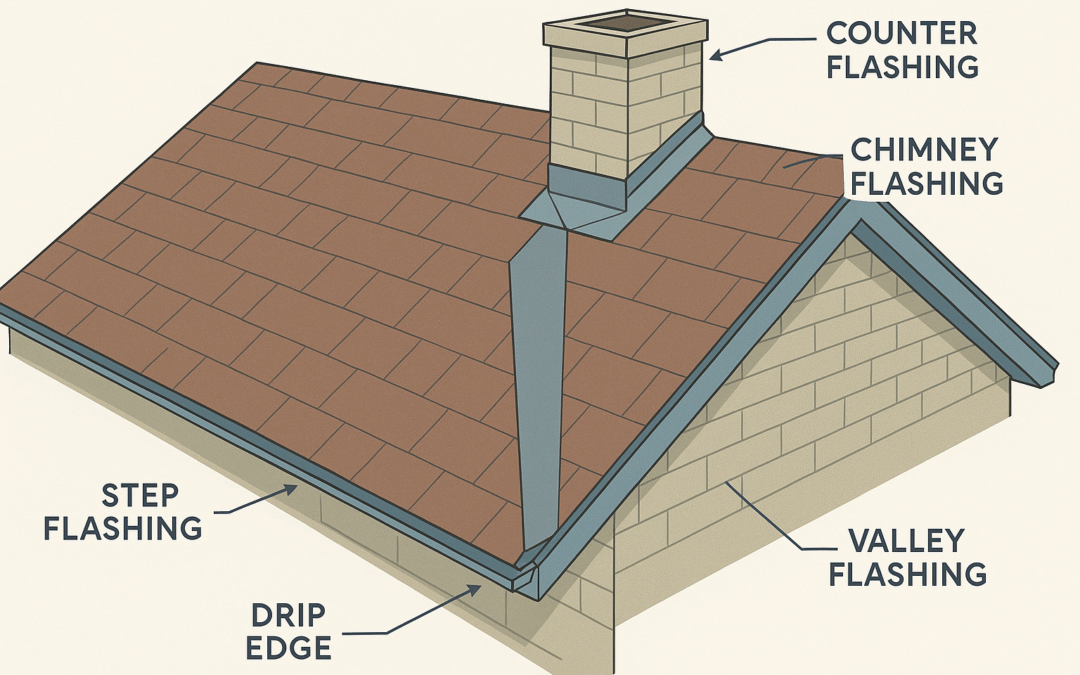While shingles and tiles get most of the attention in roofing conversations, the unsung hero of any long-lasting roof is flashing. Often overlooked, roof flashing plays a vital role in preventing leaks and protecting structural integrity—especially in a state like Minnesota, where snow, ice, and rain are constant concerns.
If you’re planning a roof replacement or wondering how to maintain your current system, understanding roof flashing is a smart place to start.
What Is Roof Flashing?
Roof flashing is a thin layer of metal—usually aluminum, copper, or galvanized steel—installed at joints or transitions on a roof. Its main purpose? To direct water away from seams where water intrusion is likely to occur.
Common areas include:
- Chimney bases
- Skylights
- Valleys (where two roof planes meet)
- Roof-to-wall transitions
- Pipe vents and dormers
When installed correctly, flashing creates a watertight seal at these high-risk areas. When installed poorly or allowed to deteriorate, leaks are almost inevitable.
Types of Roof Flashing
There are several types of flashing, each with a specific purpose:
- Step Flashing: Used where the roof meets a vertical surface like a wall or chimney.
- Valley Flashing: Installed in roof valleys to channel water off the roof.
- Vent Pipe Flashing: Surrounds plumbing vent pipes that extend through the roof.
- Drip Edge: Placed along roof edges to help water flow into gutters instead of underneath shingles.
- Counter Flashing: Installed over base flashing on chimneys or walls to protect the base layer.
Each plays a role in preventing water from penetrating your roofing system.
Why Flashing Matters in Minnesota
Minnesota’s freeze-thaw cycles make flashing especially critical. When snow accumulates on your roof and melts during the day, it can refreeze at night. Without proper flashing, this moisture can work its way into cracks or under shingles, leading to water damage, mold, or even rot.
In spring and fall, heavy rains and wind can push water into weak spots. Flashing ensures those spots stay protected.
Flashing and Ice Dams
One of the most common causes of leaks in Minnesota homes is ice dams. These occur when melting snow refreezes at the roof edge, backing up water under the shingles. Flashing—especially at eaves, valleys, and transitions—can slow or prevent this damage.
Additional protection like ice and water shield membranes, ventilation, and proper insulation all work with flashing to prevent dam formation.
Signs of Flashing Failure
You might not see your flashing every day, but you may notice the symptoms of failure:
- Water stains on ceilings or walls
- Rust streaks on siding near roof edges
- Mold or mildew smell in attic spaces
- Loose or missing shingles around chimneys or vents
Routine roof inspections from a qualified contractor like Schyma Exteriors can catch flashing issues before they lead to costly repairs.
Can Flashing Be Repaired or Reused?
Yes—flashing can often be repaired or replaced without doing a full roof replacement. However, if your flashing is rusted through, improperly installed, or damaged from a storm, it’s often best to replace the entire section.
When replacing a roof, reusing old flashing is risky unless it’s in excellent condition. New flashing ensures a full, watertight seal with the new roofing materials.
What Materials Are Best for Flashing?
Each type of metal offers pros and cons:
- Aluminum: Lightweight, corrosion-resistant, affordable, but can corrode if in contact with concrete or treated wood.
- Galvanized Steel: Durable and economical, but may rust over time.
- Copper: Long-lasting and attractive, but expensive. Often used on high-end homes or visible areas.
Your choice depends on budget, roof design, and personal preference.
Code Compliance and Flashing
Most local building codes, including those in Minnesota, require flashing on all new roof installations and major repairs. Proper flashing isn’t just best practice—it’s often required. For detailed guidelines, the International Residential Code (IRC) outlines flashing requirements under R903.2 and R703.8.
Final Thoughts
Roof flashing may not be the most exciting part of your home’s exterior, but it’s one of the most important. Whether you’re building a new home, planning a replacement, or recovering from storm damage, understanding flashing helps you make smarter decisions and prevent future issues.
For Minnesota homeowners, it’s an investment in peace of mind—keeping water out, energy costs down, and your home safe year-round.


Recent Comments